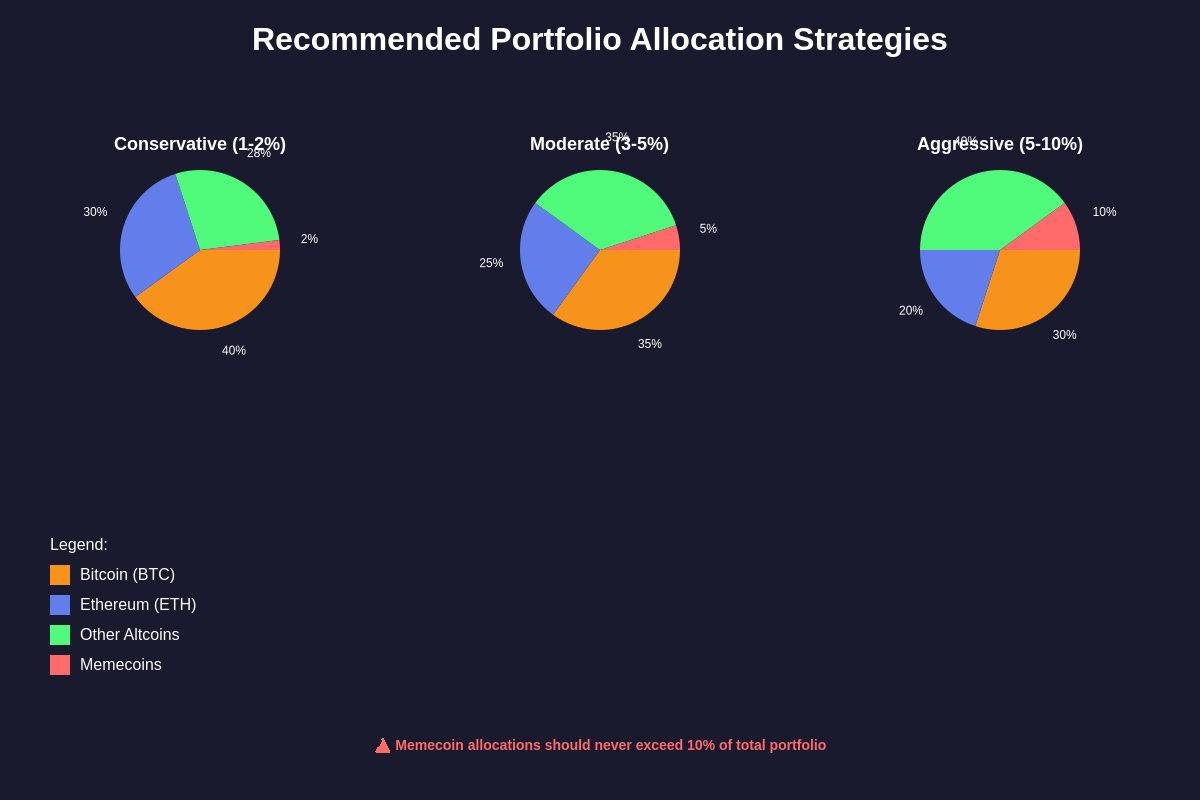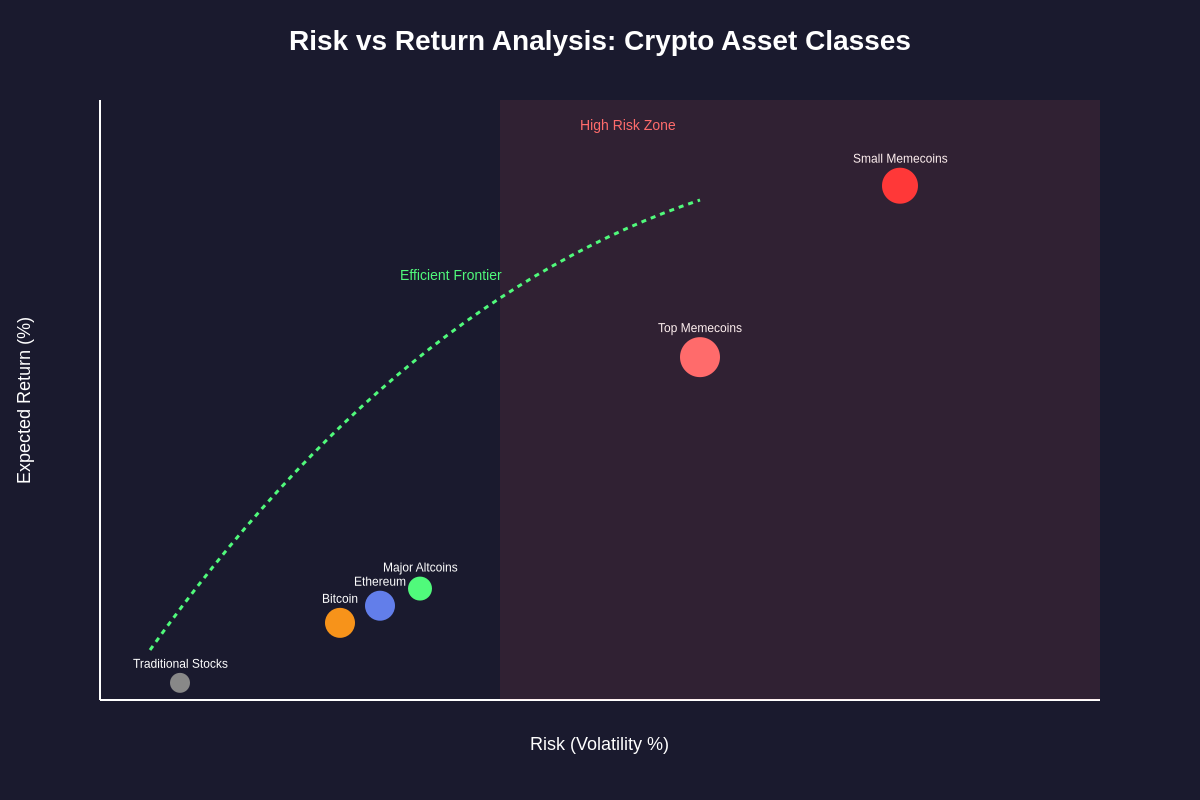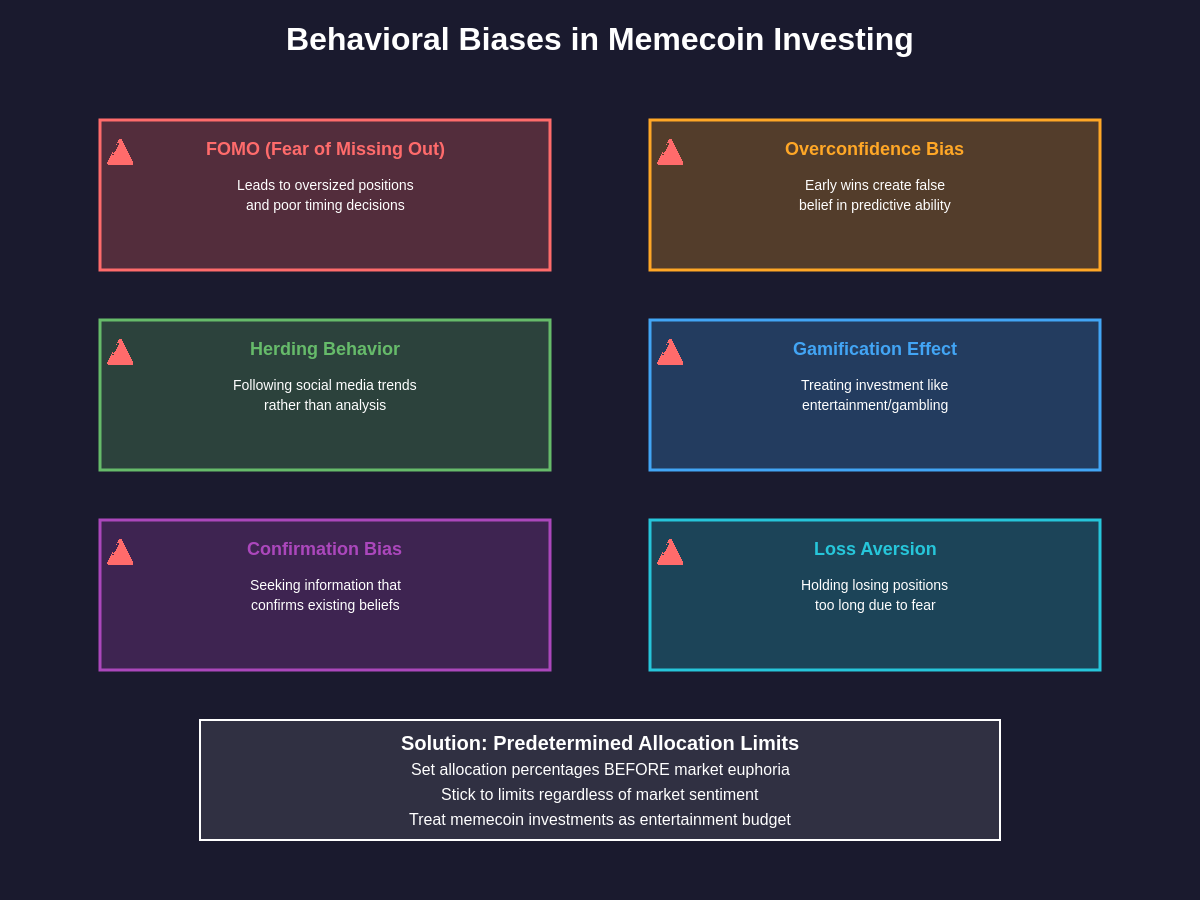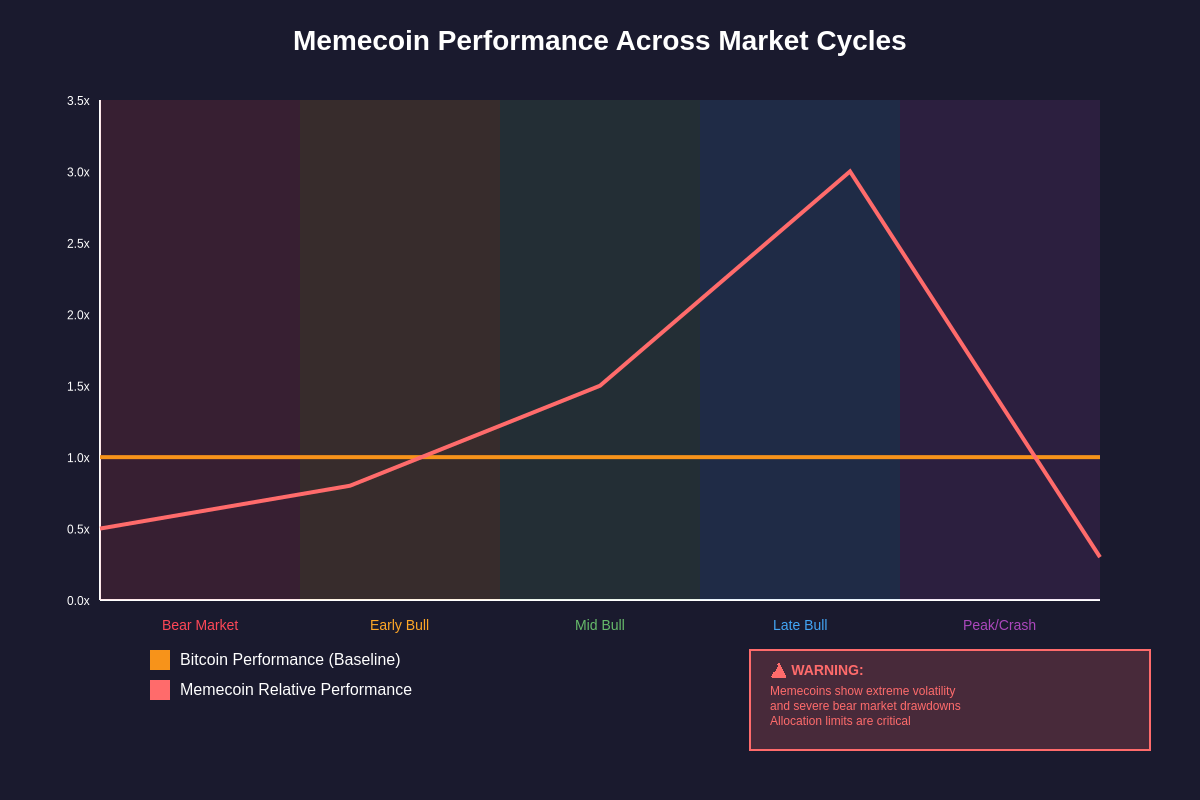The Strategic Challenge of Memecoin Investment
The question of optimal memecoin allocation within cryptocurrency portfolios has become increasingly complex as these speculative assets have evolved from internet jokes into legitimate market forces capable of generating extraordinary returns alongside devastating losses. Portfolio managers, institutional investors, and retail traders now grapple with determining appropriate exposure levels to memecoin markets while balancing the potential for outsized gains against the substantial risks inherent in these highly volatile and sentiment-driven assets.
The meteoric rise of memecoins like Dogecoin, Shiba Inu, and countless others has fundamentally challenged traditional portfolio construction methodologies, forcing investors to reconsider established principles of risk management and asset allocation. Unlike traditional cryptocurrency investments that may be evaluated based on technological merit, utility, or fundamental value propositions, memecoins derive their value primarily from community sentiment, social media trends, and speculative trading activity, creating unique challenges for portfolio optimization and risk assessment.
Historical Performance and Risk Analysis
The historical performance of memecoins presents a compelling yet cautionary tale for investors considering allocation strategies within this asset class. During the 2021 bull market, numerous memecoins delivered returns exceeding 1000%, with some achieving gains of over 10000% in remarkably short timeframes, leading many investors to allocate increasingly large portions of their portfolios to these speculative assets without fully understanding the associated risks.
However, the subsequent bear market revealed the extreme downside potential of memecoin investments, with many tokens losing 90% or more of their peak values, creating devastating losses for investors who had allocated significant portions of their portfolios to these assets. The volatility patterns observed in memecoin markets far exceed those seen in traditional cryptocurrencies, with daily price swings of 50% or more being commonplace during periods of high market activity.
The correlation analysis between memecoins and broader cryptocurrency markets reveals complex relationships that vary significantly across different market conditions. During bull markets, memecoins often exhibit amplified versions of broader market movements, rising faster and higher than established cryptocurrencies, while during bear markets they frequently experience more severe declines, suggesting that memecoin allocations may increase overall portfolio volatility rather than providing diversification benefits.
Risk-adjusted return metrics for memecoins present mixed results depending on the timeframe and specific tokens analyzed. While some memecoins have delivered exceptional Sharpe ratios during certain periods, these metrics are heavily skewed by extreme outlier performance and may not be representative of future returns, making traditional risk assessment methodologies less reliable for memecoin portfolio allocation decisions.
Traditional Portfolio Theory Applications
Modern Portfolio Theory principles, while foundational to traditional asset allocation, face significant challenges when applied to memecoin investments due to their unique risk characteristics and market behavior patterns. The efficient frontier concept becomes complicated when considering assets that may have negative expected returns over certain timeframes while maintaining the potential for extraordinary positive returns during specific market conditions.

The correlation benefits typically sought in diversified portfolios are difficult to achieve with memecoins, as these assets tend to move in similar directions during both bull and bear markets, driven more by overall market sentiment toward speculative assets than by individual token fundamentals. This high correlation among memecoins suggests that diversifying across multiple memecoin projects may not provide the risk reduction benefits typically associated with diversification strategies.
Value at Risk calculations for portfolios containing memecoins require careful consideration of tail risk events, as traditional VaR models may underestimate the probability and magnitude of extreme losses in memecoin positions. The fat-tailed distribution of memecoin returns necessitates alternative risk modeling approaches that can better capture the potential for extreme market movements and their impact on overall portfolio performance.
Asset allocation models incorporating memecoins must account for the behavioral finance aspects that drive these markets, including herding behavior, FOMO-driven investment decisions, and the impact of social media influence on price movements. These factors create market dynamics that may not be adequately captured by quantitative models based solely on historical price and return data.
Professional Investment Guidelines
Institutional investors and professional portfolio managers have developed various frameworks for incorporating speculative assets like memecoins into diversified investment strategies, with most approaches emphasizing strict position sizing limits and comprehensive risk management protocols. The consensus among professional investors suggests that memecoin allocations should typically represent no more than 1-5% of total portfolio value, with some institutions implementing even lower limits to maintain acceptable risk profiles.
Risk budgeting approaches for memecoin investments focus on limiting the potential impact of complete losses rather than optimizing for expected returns, given the high probability that memecoin investments may become worthless over time. This defensive approach to memecoin allocation recognizes that while these assets may provide lottery-ticket-like upside potential, they should be sized appropriately to ensure that total losses would not materially impact overall portfolio objectives.
Professional trading strategies for memecoins often emphasize momentum-based approaches and strict stop-loss protocols, recognizing that fundamental analysis has limited applicability in markets driven primarily by sentiment and social media trends. The technical analysis patterns observed in memecoin charts often exhibit characteristics similar to other speculative assets, though with amplified volatility and reduced reliability of traditional technical indicators.
Portfolio rebalancing strategies for accounts containing memecoins require careful consideration of tax implications and transaction costs, as the high volatility of these assets may trigger frequent rebalancing events that could erode returns through excessive trading activity. Many professional managers implement tactical rebalancing approaches that allow memecoin positions to fluctuate within predetermined ranges rather than maintaining fixed allocation percentages.
Behavioral Psychology and Investment Decisions
The psychological factors influencing memecoin investment decisions represent a critical component of portfolio allocation strategy, as these assets often appeal to cognitive biases and emotional decision-making patterns that can lead to suboptimal portfolio outcomes. The fear of missing out on extraordinary returns can drive investors to allocate disproportionate amounts of capital to memecoins, particularly during periods of high market excitement and social media buzz surrounding specific tokens.

Overconfidence bias frequently affects memecoin investors who may have achieved early success with speculative investments, leading them to increase allocation sizes beyond appropriate risk levels based on the mistaken belief that past performance predicts future results. This psychological tendency is particularly dangerous in memecoin markets where early investors may experience dramatic gains that are unlikely to be sustainable over longer timeframes.
The entertainment value and gamification aspects of memecoin investing can blur the lines between investment strategy and gambling behavior, potentially leading investors to allocate amounts they cannot afford to lose or to treat these investments as entertainment expenses rather than serious portfolio components. This psychological framework may actually be more appropriate for many retail investors, as it naturally limits allocation sizes to amounts that would not cause financial distress if lost entirely.
Social proof and herding behavior play particularly important roles in memecoin markets, where investment decisions are often driven more by community participation and social media influence than by traditional investment analysis. These psychological factors can create feedback loops that amplify both upward and downward price movements, making portfolio allocation decisions more challenging and increasing the importance of predetermined allocation limits that are maintained regardless of market sentiment.

Risk Management Frameworks
Comprehensive risk management frameworks for memecoin portfolio allocation must address the unique challenges posed by these highly speculative and volatile assets while providing practical guidelines for both institutional and retail investors. The foundation of any effective memecoin risk management approach begins with clear position sizing rules that limit potential losses to predetermined and acceptable levels relative to overall portfolio objectives and risk tolerance.
Stop-loss strategies for memecoin positions present particular challenges due to the high volatility and potential for significant gaps in trading prices during periods of market stress. Traditional percentage-based stop-losses may be triggered frequently by normal market movements, while wider stop-losses may fail to provide adequate protection against severe downturns, requiring sophisticated approaches that consider volatility-adjusted position sizing and dynamic risk management protocols.
Diversification within memecoin allocations presents its own set of challenges, as many tokens exhibit high correlations during both bull and bear markets, potentially providing less risk reduction than might be expected from traditional diversification strategies. The market cap analysis of various memecoins reveals significant concentration risk, with a small number of tokens dominating the market cap of the entire sector, suggesting that broad diversification may be difficult to achieve effectively.
Time-based risk management approaches for memecoin investments often incorporate predetermined exit strategies that are based on holding periods rather than price targets, recognizing that the speculative nature of these assets may make them unsuitable for long-term investment strategies. These approaches may include systematic partial profit-taking during periods of strong performance and complete position liquidation after predetermined timeframes regardless of performance.
Institutional vs Retail Allocation Strategies
The fundamental differences between institutional and retail investment approaches become particularly pronounced when considering memecoin portfolio allocation strategies, with institutional investors typically implementing more conservative and systematic approaches compared to the often emotional and speculative strategies employed by retail investors. Institutional frameworks generally emphasize strict governance procedures, comprehensive due diligence requirements, and quantitative risk management protocols that may be impractical or unnecessary for individual retail investors.
Institutional memecoin strategies often focus on accessing this asset class through more structured approaches such as cryptocurrency index funds that include memecoin exposure or specialized vehicles that provide diversified memecoin exposure while maintaining professional risk management oversight. These approaches allow institutions to participate in potential memecoin upside while maintaining adherence to fiduciary responsibilities and regulatory compliance requirements.
Retail investors may have greater flexibility in their memecoin allocation strategies, allowing for more aggressive position sizing and speculative approaches that would be inappropriate for institutional portfolios. However, this flexibility also creates greater potential for behavioral mistakes and emotional decision-making that can lead to substantial losses, making education and self-discipline critical components of retail memecoin investment strategies.
The regulatory environment surrounding memecoin investments varies significantly between institutional and retail contexts, with institutional investors facing additional compliance requirements and reporting obligations that may influence their allocation decisions. These regulatory considerations often favor more conservative allocation approaches and may require additional documentation and justification for memecoin investments within institutional portfolios.
Market Cycle Considerations
Understanding the cyclical nature of cryptocurrency markets provides crucial context for memecoin portfolio allocation decisions, as these assets tend to exhibit exaggerated versions of broader market cycles with amplified gains during bull markets and more severe losses during bear markets. Historical analysis suggests that memecoin performance is highly dependent on overall market sentiment toward risk assets, making timing considerations particularly important for allocation strategies.

During early bull market phases, memecoins often underperform established cryptocurrencies as investors focus on tokens with stronger fundamental value propositions, suggesting that early-cycle allocation strategies might emphasize lower memecoin weightings. As bull markets mature and speculative sentiment increases, memecoins typically begin to outperform, potentially justifying tactical increases in allocation levels for investors comfortable with increased risk exposure.
Bear market dynamics for memecoins are characterized by particularly severe drawdowns and extended periods of underperformance, often lasting longer than broader cryptocurrency market corrections. This pattern suggests that bear market allocation strategies should emphasize preservation of capital and potentially complete elimination of memecoin exposure until more favorable market conditions emerge.
The transition periods between bull and bear markets present unique challenges and opportunities for memecoin allocation strategies, as these assets may experience extreme volatility during market regime changes. Sophisticated investors may attempt to time these transitions through tactical allocation adjustments, though the difficulty of accurately predicting market cycle turning points makes such strategies inherently risky and potentially counterproductive.
Tax Implications and Regulatory Considerations
The tax treatment of memecoin investments varies significantly across jurisdictions and can have material impacts on optimal allocation strategies, particularly for investors in high tax brackets or those subject to complex international tax obligations. The high turnover rates typical of memecoin trading strategies may result in predominantly short-term capital gains treatment, reducing after-tax returns and potentially making these investments less attractive compared to long-term investment strategies.
Regulatory uncertainty surrounding memecoins and cryptocurrency investments more broadly creates additional considerations for portfolio allocation decisions, as potential future regulatory changes could significantly impact the accessibility, liquidity, or legal status of these investments. Investors must consider the possibility that regulatory developments could require forced liquidation of memecoin positions or create additional compliance burdens that affect the attractiveness of these investments.
The reporting requirements for cryptocurrency investments, including memecoins, continue to evolve across different jurisdictions, potentially creating administrative burdens that may influence optimal allocation decisions. These compliance costs may be proportionally higher for smaller investments, potentially favoring either very small “play money” allocations or larger strategic positions that justify the administrative overhead.
Anti-money laundering and know-your-customer requirements affecting cryptocurrency investments may limit the platforms and strategies available for memecoin investing, potentially constraining allocation options and requiring careful consideration of counterparty risks associated with different trading venues and custody solutions.
Technology and Infrastructure Considerations
The technological infrastructure supporting memecoin investments presents unique considerations for portfolio allocation decisions, as many of these tokens are built on various blockchain networks with different security, scalability, and decentralization characteristics. The concentration of many memecoins on specific blockchain platforms creates infrastructure risk that may not be present in more diversified cryptocurrency allocations.
Smart contract risks associated with memecoin projects represent a significant consideration for allocation strategies, as many tokens incorporate complex smart contract functionality that may contain bugs, vulnerabilities, or malicious code that could result in total loss of invested capital. The limited auditing and security review processes typical of memecoin projects compared to established cryptocurrency projects suggest that allocation sizes should account for elevated smart contract risk.
Liquidity considerations for memecoin investments vary dramatically across different tokens and market conditions, with many projects experiencing significant liquidity challenges during periods of market stress. This liquidity risk may make it difficult to execute large trades or exit positions during adverse market conditions, potentially making memecoins unsuitable for portfolios that require regular liquidity or have specific liquidity requirements.
The custody and security infrastructure for memecoin investments often relies on the same systems used for other cryptocurrency investments, though the speculative nature of many memecoin projects may make them attractive targets for various types of attacks or fraud. Investors must ensure that their custody solutions are appropriate for the elevated risks associated with memecoin investments while maintaining reasonable cost structures.
Alternative Investment Vehicles
Exchange-traded products and investment funds focusing on memecoin exposure provide alternative approaches to direct token allocation, potentially offering professional management, diversification benefits, and simplified tax reporting compared to direct memecoin investments. These vehicles may be particularly appropriate for investors seeking memecoin exposure while maintaining traditional portfolio management approaches and avoiding the technical complexity of direct cryptocurrency investment.
Structured products incorporating memecoin exposure may provide risk management features such as principal protection or capped upside participation that could make these speculative assets more suitable for conservative portfolios. However, the costs and complexity of these products must be carefully evaluated against their potential benefits, particularly given the already high volatility and potential returns available through direct memecoin investment.
Derivatives markets for memecoins, while limited compared to established financial markets, provide additional tools for implementing allocation strategies through options, futures, or other derivative instruments. These tools may allow for more sophisticated risk management approaches or leveraged exposure strategies, though they also introduce additional counterparty risks and complexity that may not be appropriate for all investors.
The emergence of decentralized finance protocols incorporating memecoin assets creates additional investment vehicles and strategies, including liquidity provision, yield farming, and lending markets that may provide alternative ways to gain memecoin exposure while potentially generating additional returns. However, these strategies often involve elevated risks and complexity that require careful evaluation and may not be suitable for traditional portfolio allocation approaches.
Future Market Evolution and Strategic Implications
The evolving regulatory landscape for cryptocurrency investments will likely have significant impacts on memecoin markets and optimal allocation strategies, with potential developments including clearer legal frameworks, enhanced consumer protections, and standardized disclosure requirements that could affect the risk-return profiles of these investments. Investors should consider how potential regulatory changes might impact their allocation strategies and maintain flexibility to adjust positions as the regulatory environment evolves.
Institutional adoption of cryptocurrency investments continues to expand, potentially creating new demand sources for established memecoins while also increasing market efficiency and reducing the extreme volatility that has historically characterized these markets. This institutional involvement could fundamentally alter the risk-return characteristics of memecoin investments, potentially making larger allocation percentages more appropriate for certain types of portfolios.
Technological developments in blockchain infrastructure, including improved scalability, enhanced security features, and reduced transaction costs, may impact the practical considerations surrounding memecoin investments and portfolio allocation strategies. These developments could make memecoin investing more accessible and cost-effective, potentially supporting larger allocation sizes or more active trading strategies.
The integration of cryptocurrency and traditional financial markets continues to accelerate, potentially creating new correlation patterns and risk relationships that could affect optimal memecoin allocation strategies. As these markets become more interconnected, the diversification benefits and risk characteristics of memecoin investments may change, requiring ongoing reassessment of allocation approaches and risk management strategies.
Practical Implementation Guidelines
The practical implementation of memecoin allocation strategies requires careful attention to execution details, including platform selection, timing considerations, and ongoing monitoring protocols that can significantly impact investment outcomes. The choice of trading platforms and custody solutions should prioritize security, liquidity, and cost efficiency while maintaining appropriate insurance coverage and regulatory compliance.
Dollar-cost averaging strategies may be particularly appropriate for memecoin investments given their high volatility and difficulty in timing market entry points effectively. These systematic investment approaches can help reduce the impact of market timing decisions while maintaining disciplined allocation sizing, though investors should be prepared for extended periods of underperformance during bear market conditions.
Rebalancing protocols for portfolios containing memecoins should account for the high volatility of these assets and the potential for frequent threshold breaches that could trigger excessive trading activity. Many successful strategies implement quarterly or semi-annual rebalancing schedules with tolerance bands that allow for significant price movements without requiring immediate action.
The monitoring and reporting requirements for memecoin investments may exceed those for traditional investments due to their volatility and speculative nature. Investors should establish clear performance benchmarks, risk monitoring protocols, and decision frameworks for adjusting allocation sizes based on changing market conditions or portfolio performance.
Conclusion and Strategic Recommendations
The question of appropriate memecoin allocation within cryptocurrency portfolios requires careful consideration of individual risk tolerance, investment objectives, and market conditions, with most evidence suggesting that conservative allocation approaches are most appropriate for the majority of investors. The extreme volatility and speculative nature of memecoin investments make them unsuitable as core portfolio holdings, though they may serve as satellite positions for investors comfortable with the associated risks and potential for total loss.
Professional investment management approaches consistently emphasize position sizing limits of 5% or less for speculative investments like memecoins, with many institutional frameworks implementing even lower limits to maintain acceptable overall portfolio risk profiles. These conservative approaches recognize the lottery-ticket characteristics of memecoin investments while acknowledging their potential for extraordinary returns during favorable market conditions.
The behavioral and psychological aspects of memecoin investing represent critical considerations that may be more important than traditional financial analysis in determining appropriate allocation strategies. Investors must honestly assess their ability to maintain disciplined investment approaches during periods of extreme market volatility and social media excitement surrounding specific memecoin projects.
Looking forward, the evolving cryptocurrency landscape suggests that memecoin markets may mature and become less volatile over time, potentially supporting higher allocation percentages for investors comfortable with continued speculation. However, until such market evolution occurs, conservative allocation approaches that limit potential losses while maintaining upside participation appear most prudent for the majority of investors considering memecoin exposure within their cryptocurrency portfolios.
The integration of comprehensive market analysis tools and sophisticated risk management frameworks will remain essential components of successful memecoin allocation strategies, regardless of the specific allocation percentages chosen by individual investors.
Disclaimer: This article is for educational and informational purposes only and should not be construed as financial advice. Cryptocurrency investments, including memecoins, are highly speculative and volatile, and may result in significant financial losses. Past performance does not guarantee future results. Readers should conduct their own research and consult with qualified financial advisors before making any investment decisions. The author and publisher are not responsible for any financial losses that may result from the use of information contained in this article.